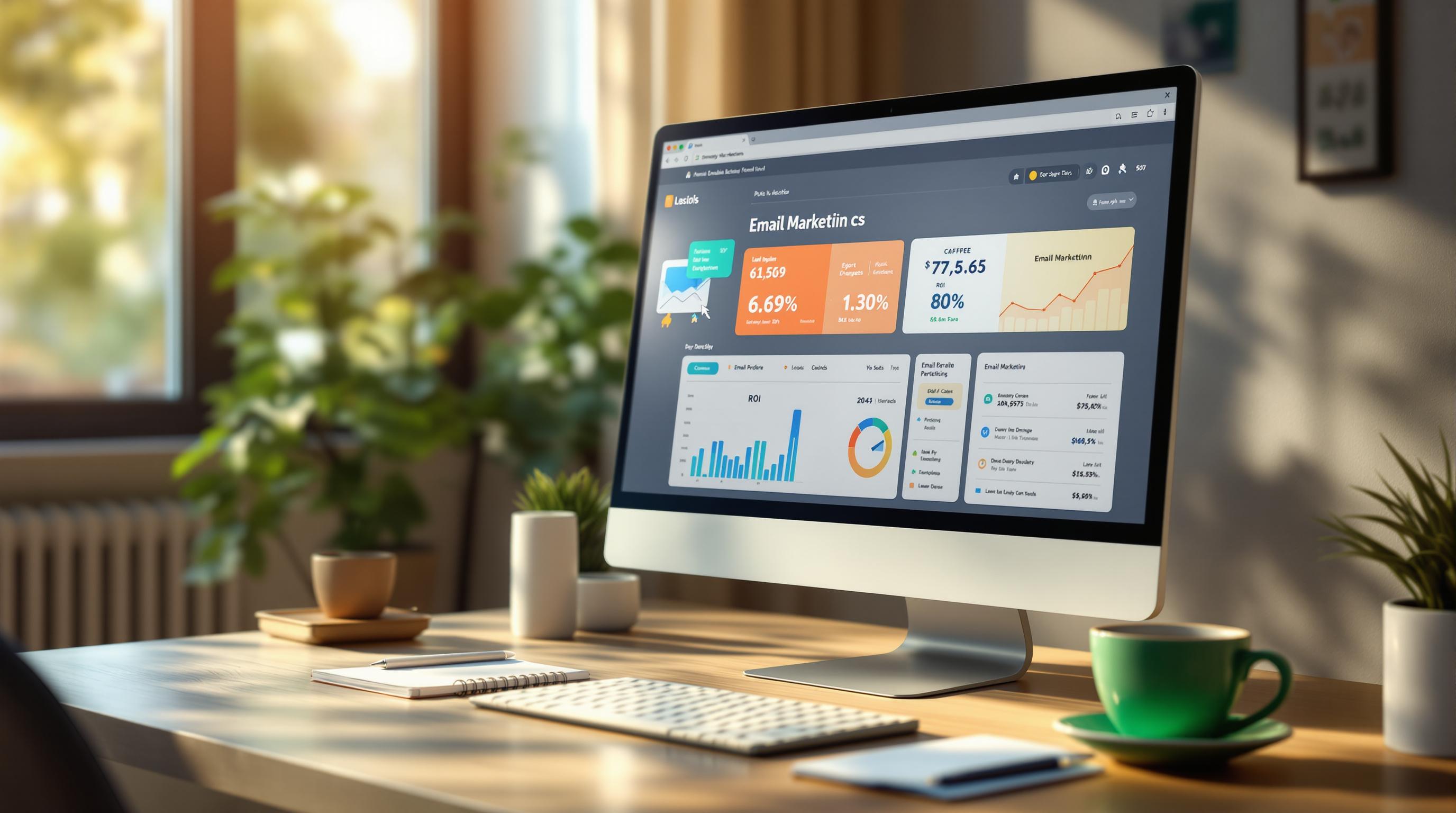In 2025, real-time email analytics tools are essential for businesses to track, optimize, and improve email campaigns instantly. Here’s a quick look at the top tools for real-time email analytics:
- Brevo (formerly Sendinblue): Advanced real-time dashboards, A/B testing, and seamless integrations with over 150 platforms.
- Constant Contact: User-friendly interface with heatmaps, real-time tracking, and multi-account management.
- Mailgun: Developer-friendly platform with multidimensional analytics and OLAP cube technology for high-volume email campaigns.
- EmailAnalytics: Focuses on team productivity, response times, and email volume tracking.
- Right Inbox: Gmail extension offering real-time tracking, engagement insights, and workflow automation.
- SalesHandy: Tailored for sales teams with detailed tracking and high-volume outreach capabilities.
- Salesloft: Combines email analytics with sales engagement and revenue intelligence tools.
- La Growth Machine: Multi-channel outreach combining email, LinkedIn, and X (formerly Twitter) engagement.
- MailerLite: Affordable analytics tool with heatmaps, automation tracking, and e-commerce insights.
- Zoho Campaigns: Designed for Zoho ecosystem users with advanced segmentation, geographic tracking, and over 50 reporting options.
Quick Comparison
| Tool | Starting Price | Best For | Key Features | User Rating (out of 5) |
|---|---|---|---|---|
| Brevo | Custom Pricing | Multi-channel users | Real-time dashboards, A/B testing | 4.5 |
| Constant Contact | $12/month | Beginners | Heatmaps, multi-account support | 4.5 |
| Mailgun | Pay-as-you-go | Developers | API, multidimensional analytics | 4.6 |
| EmailAnalytics | $5/month | Productivity tracking | Gmail/Outlook integration | 4.4 |
| Right Inbox | $7.95/month | Gmail users | Real-time tracking, automation | 4.8 |
| SalesHandy | $36/month | Sales teams | Cold email tracking, automation | 4.6 |
| Salesloft | Custom Pricing | Large sales teams | CRM integration, revenue insights | 4.5 |
| La Growth Machine | $60/month | Multi-channel outreach | LinkedIn, email integration | 4.9 |
| MailerLite | $10/month | Budget-conscious users | Heatmaps, automation workflows | 4.4 |
| Zoho Campaigns | Free for 2,000 | Zoho ecosystem users | Advanced segmentation, analytics | 4.4 |
These tools cater to different needs, from small businesses to large enterprises. Choose based on your business goals, integration needs, and budget.
Top 5 Email Marketing Software in 2025 | Best Tools for Small Business, eCommerce, and Newsletters
1. Brevo (formerly Sendinblue)
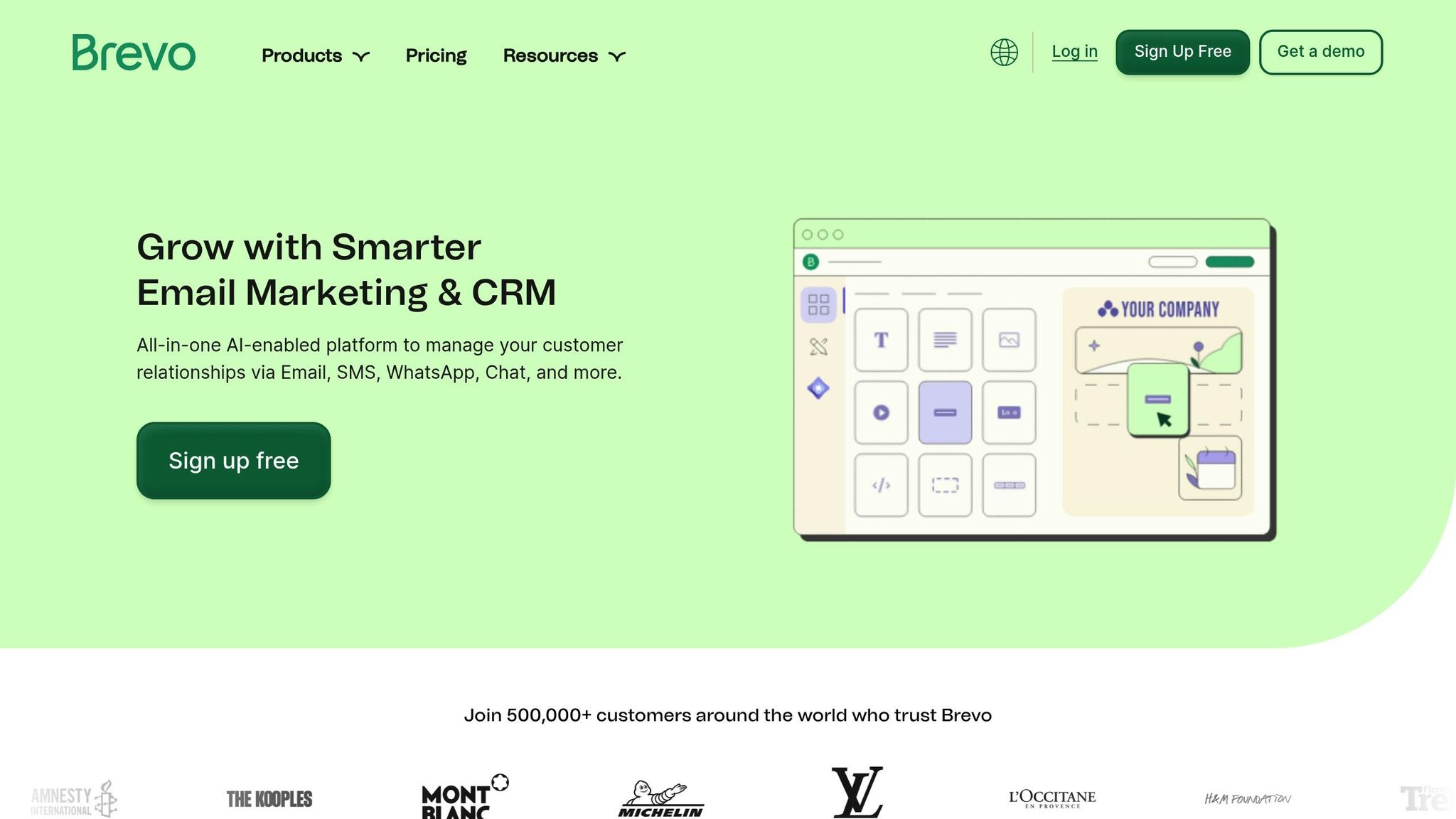
In the fast-paced world of email marketing, staying on top of real-time data is no longer optional - it's essential. Brevo, previously known as Sendinblue, delivers the advanced tools enterprises need to keep up. With over 500,000 customers globally, Brevo has built a reputation for offering powerful email analytics and enterprise-ready solutions.
Real-time Analytics Capabilities
Brevo provides a real-time dashboard that tracks key metrics like opens, clicks, unsubscribes, conversions, and even campaign revenue. For businesses looking to refine their strategies further, features like campaign comparisons and A/B testing are also available. While basic plans cover essential metrics, the Business plans go a step further, offering geolocation data and heatmaps to enhance targeting.
Seamless Integration with Enterprise Tools
Brevo connects effortlessly with over 150 popular digital platforms, including CRMs, content management systems, and e-commerce tools. For businesses with unique needs, Brevo's open API allows for fully customized integrations. These integrations aren't just for show - they deliver results. For example, syncing Brevo with tools like Shopify, Salesforce, and Google Analytics has been shown to boost conversions by as much as 30%.
"Take advantage of our many custom integrations or leverage our open API that makes connection to any platform possible." – Brevo
Designed for High-Volume Emailing
Scalability is a must for enterprise operations, and Brevo delivers. There are no daily sending limits on its bulk email server, and businesses can opt for custom sending volumes and contact limits tailored to their needs. Features like dedicated IPs, priority sending, unlimited subscribers, sub-account management, advanced segmentation, and a robust messaging API ensure high deliverability and precise targeting, even at massive scales.
Enterprise Pricing and Cost Efficiency
Brevo's Business and Enterprise plans are offered with custom pricing based on specific sending volumes and contact requirements. For many companies, the savings are significant. Kevin Yen, Head of Growth at AI Camp, highlighted that switching to Brevo saved his company $30,000 annually compared to HubSpot.
With a G2 rating of 4.5 out of 5 stars and a 4 out of 5 rating from EmailToolTester, Brevo strikes a balance between powerful features, scalability, and affordability. For enterprises looking to master real-time email analytics, it’s a strong contender.
2. Constant Contact

Constant Contact is a trusted email marketing platform serving over 600,000 customers worldwide. With an impressive 97% deliverability rate and a solid 4.5/5 rating on Gartner, it’s a go-to solution for businesses seeking reliable email marketing tools.
Real-time Analytics Capabilities
Constant Contact offers real-time tracking to monitor email campaign performance. Users can see whether emails were delivered, opened, deleted, or if recipients clicked on links. Beyond basic stats, the platform provides detailed reports that help businesses identify which contacts are engaged and which aren’t over time.
Data is displayed in easy-to-read visual graphs, offering instant insights into campaign performance. One standout feature is the click-tracking heat map, which highlights the most-clicked links, making it simple to pinpoint what content resonates best with your audience. Additionally, the platform’s single dashboard is designed for organizations with multiple accounts or franchise locations, offering a clear overview of all campaigns.
"The dashboard is extremely easy to navigate. The layout is clean. The block builder for campaigns is simple drag-and-drop, and there's plenty of memory to store photos and PDFs. The data is easy to understand (opens, CTR, etc.)." - David M., Director of Communications and PR
These analytics tools integrate smoothly with other enterprise systems, simplifying campaign management.
Integration with Enterprise Tools and Platforms
Constant Contact connects with popular platforms like Salesforce, Google Analytics 4, and Shopify. This integration allows businesses to sync contacts, automate reporting, and create personalized subject lines, which can improve open rates by up to 26%. By centralizing customer data and automating tasks, the platform helps streamline workflows.
The platform’s segmentation tools also leverage integrated data, enabling businesses to create targeted email lists based on specific criteria. However, some integrations or custom development may come with additional costs.
These features make Constant Contact a flexible option for businesses looking to manage large-scale campaigns efficiently.
Scalability for High Email Volumes
Constant Contact is built to handle high-volume email campaigns, earning a 4.5/5 rating for scalability from Gartner Peer Insights. According to their data, 85% of users would recommend the service.
One manufacturing company with annual revenue between $3 billion and $10 billion shared that the platform’s reporting tools were both thorough and accurate, cutting the time needed to create professional emails in half.
That said, businesses with more advanced needs may need to invest in additional features like advanced segmentation.
Pricing and Value for Enterprise Features
Pricing starts at $12/month and scales based on the size of your contact list. Custom pricing options are available for larger enterprises. For organizations with multiple locations or teams, the multi-account solution provides centralized brand control while allowing individual departments to manage their campaigns independently.
"Constant Contact is great for colleges and universities. It's extremely easy to use and can accommodate different departments and many different users." - Verified G2 user in higher education
With email marketing boasting an average return of $36 for every $1 spent, Constant Contact offers a straightforward pricing model and dependable performance. It’s an excellent choice for businesses focused on ease of use, real-time analytics, and consistent results.
3. Mailgun

Mailgun is a robust email infrastructure platform, trusted for sending over 450 billion emails each year. Tailored for businesses handling high email volumes, it combines enterprise-level scalability with powerful real-time analytics. This makes it a go-to solution for companies that need dependable email delivery on a massive scale.
Real-time Analytics Capabilities
Mailgun’s real-time analytics tools allow businesses to fine-tune their email campaigns on the fly. Its platform provides customizable, real-time email data, ensuring senders maintain peak performance. What sets it apart is its multidimensional approach, enabling users to analyze data across three dimensions - such as Country, Domain, Time, Sending IP, and more - on a single dashboard. With over 40 data points available, users can create granular filters like "equals", "does not equal", "contains", or "does not contain" to track specific metrics.
The platform uses OLAP cube technology to process large datasets quickly and accurately. Other features include Integrated Bounce Classification, which identifies and reduces bounce-related issues, and enhanced email logs that let users dive straight into detailed metrics from the dashboard with just one click. Additionally, Mailgun’s webhooks provide real-time tracking of email events - such as opens, clicks, bounces, and deliveries - offering businesses a clear view of their email performance.
Integration with Enterprise Tools and Platforms
Mailgun’s versatility shines through its seamless integration with enterprise systems via RESTful APIs and advanced webhook functionality. For instance, it connects with monitoring tools like Datadog, enabling real-time performance tracking. By setting up webhooks in the Mailgun Control Panel, businesses can automate monitoring workflows, triggering HTTP POST requests to APIs when email events occur. This allows instant issue resolution through tools like Datadog dashboards and alerts.
The platform also integrates with Email on Acid for email testing and quality assurance, as well as marketing tools like Phonexa. These integrations simplify workflows and enhance Mailgun’s role within enterprise email ecosystems.
"Mailgun makes it easy to build and manage a large-scale email marketing application with thousands of customers sending millions of emails." – Chris Hexton, CEO & Co-Founder, Vero
Scalability for High Email Volumes
Designed for heavy-duty email operations, Mailgun’s cloud-based architecture handles millions of emails daily with ease. It dynamically adjusts resources to meet demand, ensuring rapid delivery even during peak times. With performance packages capable of sending up to 15 million emails per hour, Mailgun guarantees reliable delivery while meeting compliance standards.
The platform’s effectiveness is evident in real-world use cases. For example, Dribbble, a community for designers, has seen significant improvements in its email performance. Michael Sacca, Vice President of Product at Dribbble, highlights the impact:
"For us, at the volume we're sending – every fraction of a percentage means a potential customer, and as a community of designers, it's our job to create meaningful touchpoints. High deliverability ensures that our messages and our reach are seen; any improvement in our email program has a huge effect on our business."
Mailgun users have reported a 21% reduction in bounces, a 65% boost in open rates, and a 100% increase in clicks.
Pricing and Value for Enterprise Features
Mailgun offers a pay-as-you-go pricing model, making it a flexible option for businesses of all sizes. High-volume senders can also benefit from volume discounts, ensuring cost-efficiency. Its suite of features - including multidimensional analytics, advanced filtering, webhook integrations, and tools for enterprise-level deliverability - provides excellent value. The Mailgun Optimize feature further enhances performance by proactively addressing deliverability issues before they escalate.
Handling over 450 billion emails annually, Mailgun proves to be a reliable choice for businesses managing complex email operations. Its combination of detailed analytics, scalable infrastructure, and seamless integrations makes it a strong contender for enterprises that depend on high-volume email communications.
4. EmailAnalytics
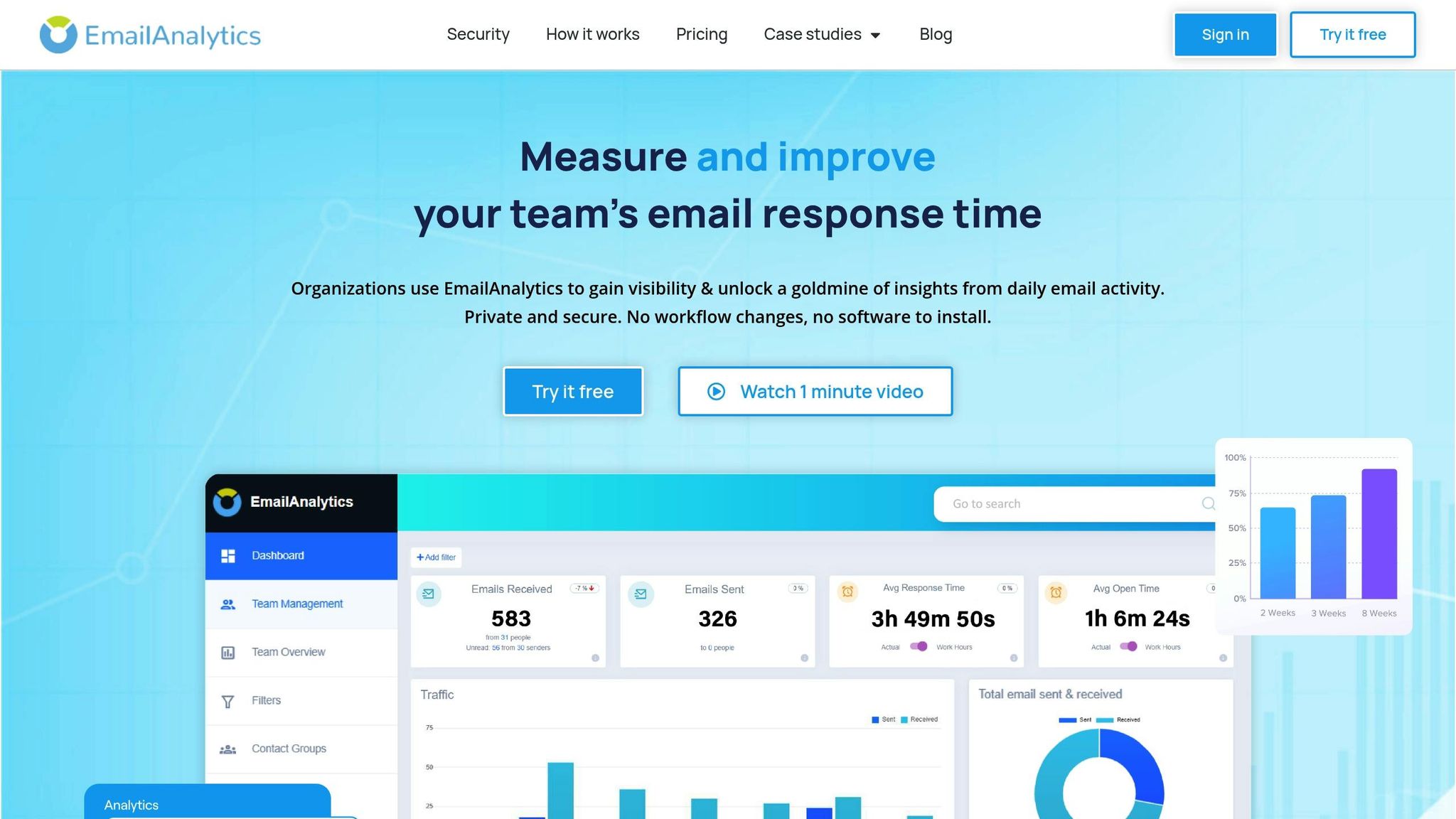
EmailAnalytics is a management-focused email analytics tool designed to give teams a clear view of their email activity. Unlike traditional email marketing tools that focus on campaign-related metrics, this platform quietly tracks productivity, response times, and email volume across an organization. It combines performance monitoring with actionable insights, helping teams stay on top of their email operations.
Real-time Analytics Capabilities
EmailAnalytics offers real-time monitoring of key email performance metrics that influence business outcomes. It tracks email volume, response times, and productivity patterns for Gmail and Google Workspace users, with live inbox alerts and SLA countdown timers . By visualizing email trends, teams can identify peak activity periods, making resource allocation more efficient. A productivity scoring system also provides managers with a quick snapshot of team performance without needing to sift through detailed reports.
The platform’s emphasis on response time analytics is particularly impactful. Research shows that 35-50% of sales go to the vendor who responds first, and following up within an hour can increase success rates by 7x . EmailAnalytics users typically see a 42.5% improvement in response times, a massive advantage considering professionals spend an average of 50% of their workday on email . These tools not only improve team efficiency but also integrate smoothly with existing systems.
Integration with Enterprise Tools and Platforms
EmailAnalytics works seamlessly with major email platforms like Gmail, Google Workspace, Outlook, and Microsoft 365. As a Google-verified app and Google Cloud Partner, it ensures secure, reliable connections with enterprise systems.
Using Gmail and Outlook APIs, the platform integrates with leading CRM systems without disrupting current workflows. This compatibility means businesses can access powerful analytics without overhauling their existing setups.
With over 10,000 businesses relying on EmailAnalytics, it’s proven to be a reliable tool for tracking email performance in enterprise environments. Unlike other tools that require changes to email workflows, EmailAnalytics operates quietly in the background, making it easy to implement and use.
"EmailAnalytics has been a game-changer for us... It's one of the most important tools that we use." – Matthew Hellrung, Co-founder and Partner, Meltzer Hellrung
Scalability for High Email Volumes
Designed to handle large-scale email traffic, EmailAnalytics is ideal for enterprises. It supports unlimited employee inboxes, giving managers insights to rebalance workloads and boost productivity across teams . By monitoring organization-wide email activity, managers can identify top performers and ensure workloads are evenly distributed.
With the ability to set SLA goals and track progress in real time, the platform helps maintain consistent service standards as businesses expand.
Pricing and Value for Enterprise Features
EmailAnalytics offers a free trial, with paid plans ranging from $5 to $15 per month, depending on the number of users . For larger organizations, the Pro plan costs $15 per inbox per month, with bulk discounts available for enterprise-level deployments.
Given its comprehensive analytics tools and the proven 42.5% improvement in response times, the pricing provides strong value. The platform’s focus on improving team productivity and manager oversight makes it especially useful for businesses where quick email responses are critical to revenue and customer satisfaction.
5. Right Inbox
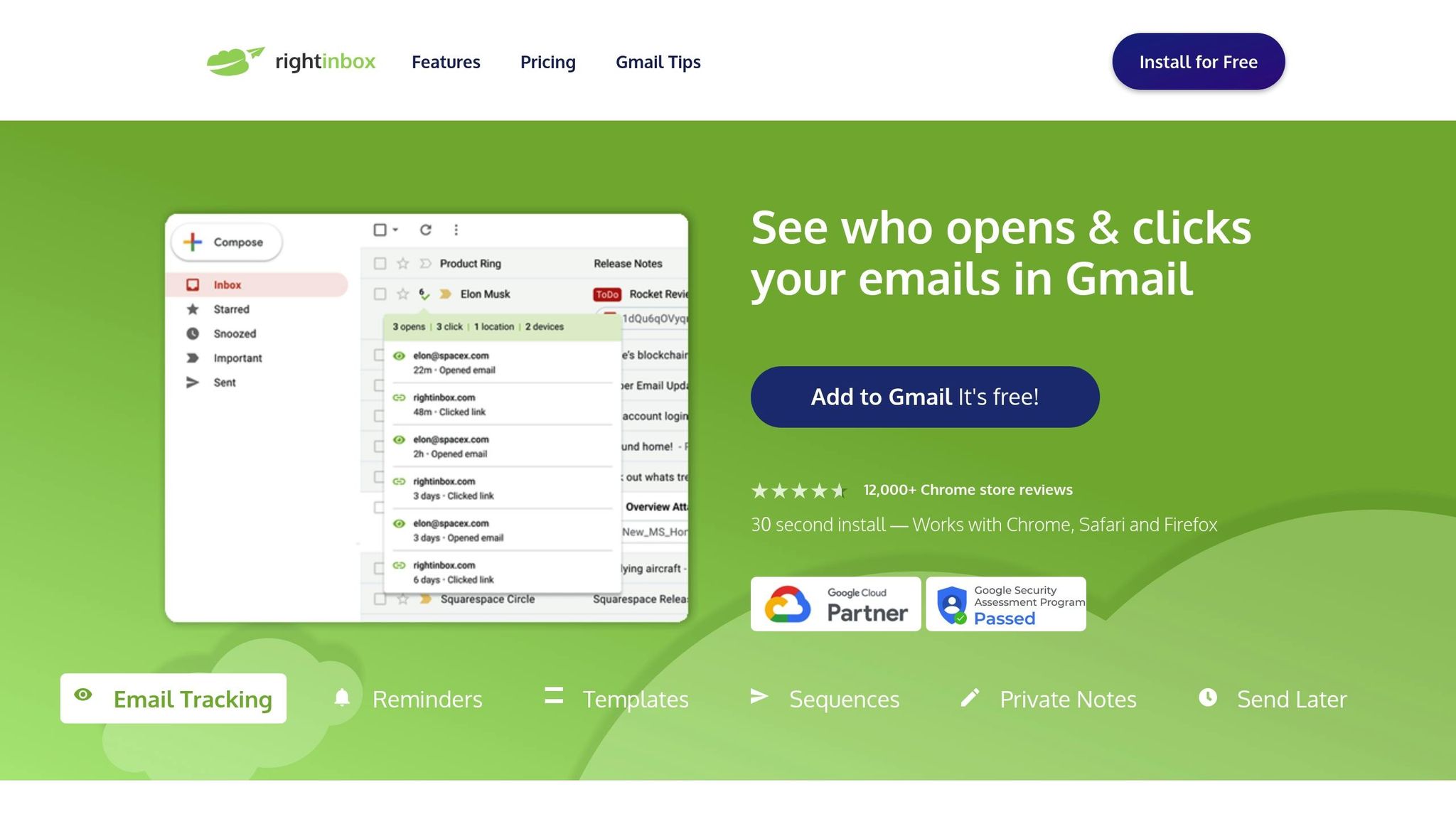
Right Inbox is a Gmail-focused email analytics tool that integrates seamlessly with your inbox as a Chrome extension. It takes just 30 seconds to set up and has earned the trust of over 250,000 professionals worldwide. This tool brings real-time tracking, detailed engagement insights, and workflow automation directly to your Gmail, working smoothly with Chrome, Safari, and Firefox.
What makes Right Inbox stand out is its ability to track email engagement in real time while offering workflow automation. Unlike larger email marketing platforms, it focuses on individual email performance, giving users immediate insights into recipient behavior and engagement patterns.
Real-time Analytics Capabilities
Right Inbox provides in-depth, real-time insights into how your emails perform - all within your Gmail interface. It tracks who opens your emails, when they open them, and even who chooses to ignore them. You'll get details like the exact time, device used, location, and IP address for each open. Beyond tracking email opens, it monitors link clicks and other interactions, helping you identify your most engaged prospects. This allows you to prioritize timely follow-ups.
The tool also supports automated sequences, which can be triggered when recipients open emails multiple times or click specific links. Plus, its engagement-based lead scoring ensures you focus on the prospects most likely to convert.
Integration with Enterprise Tools and Platforms
Right Inbox integrates effortlessly with most popular CRM systems. It can sync email threads automatically using smart BCC or toolbar options. Even if your CRM doesn’t have a direct integration, the smart BCC feature ensures your email activity is synced. And since it’s natively built for Gmail, all tracking features are available directly in your inbox.
Scalability for High Email Volumes
For businesses dealing with high email volumes, Right Inbox offers tools like bulk mail merge, automated follow-ups, and personalized outreach at scale. It’s designed to handle large campaigns while maintaining a high level of performance, as reflected in its 4.7 out of 5-star rating from over 12,000 reviews on the Chrome Web Store. Bulk email tools allow for personalized messaging at scale, while automated sequences manage follow-ups without requiring manual effort. With email traffic expected to hit 347 billion daily messages by 2023, according to Radicati research, these features are invaluable for growing businesses.
Pricing and Value for Enterprise Features
Right Inbox offers flexible pricing options, starting with a free plan. Paid plans begin at $7.95 per month for personal users and $14.95 per month for professionals, including features like tracking, templates, scheduling, and CRM integration. This pricing is competitive given the range of tools available. The platform also boasts a G2 Crowd rating of 4.8, highlighting strong user satisfaction. While users often praise its role in managing email communications and follow-ups, some have noted occasional tracking accuracy issues.
Next, we’ll dive into SalesHandy, another tool that pushes the boundaries of real-time email analytics for enterprises.
6. SalesHandy
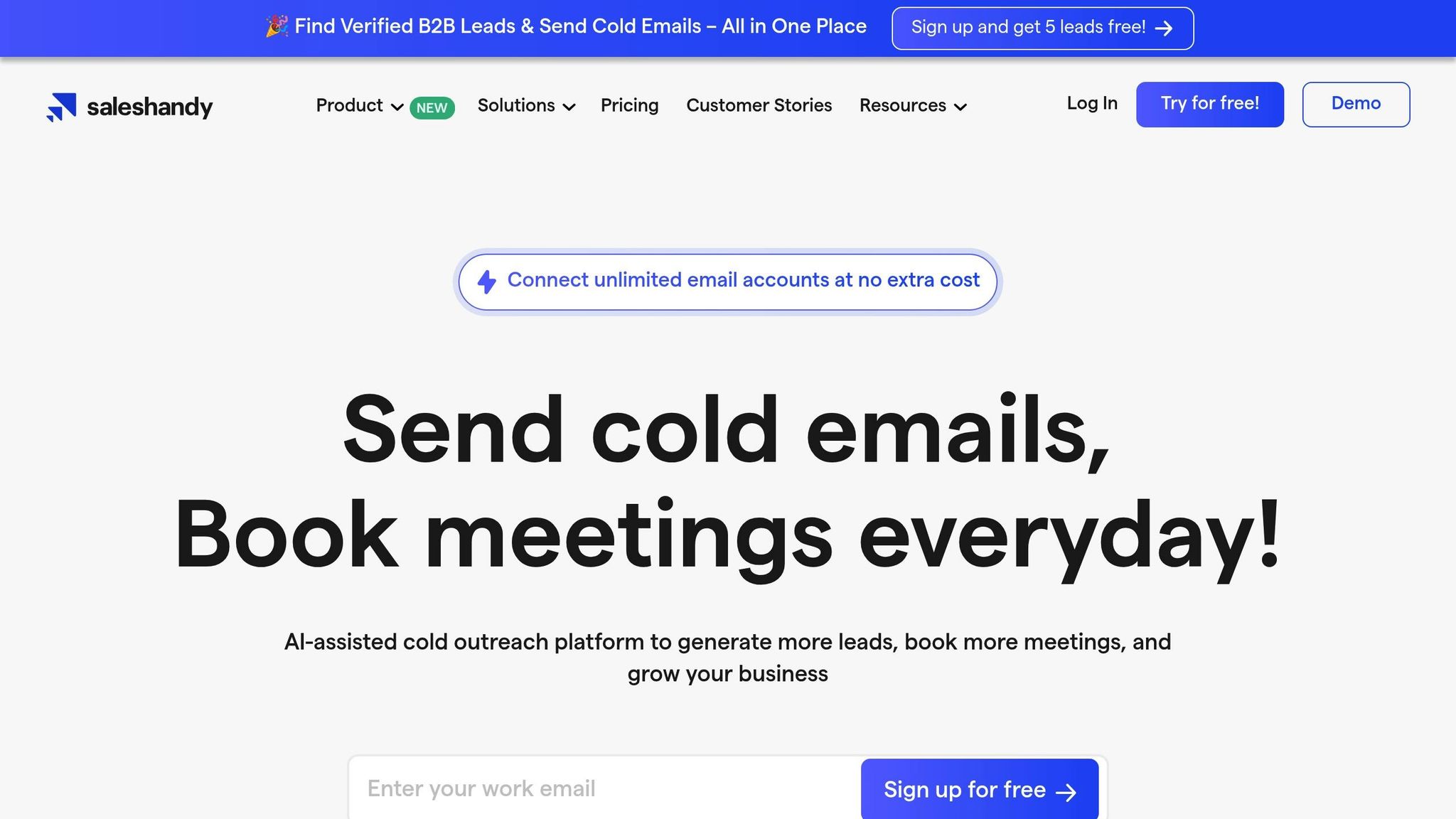
SalesHandy is an email analytics platform designed to make cold email outreach more efficient and scalable. With a 4.6/5 rating on G2 (based on over 710 reviews) and 4.5/5 on Capterra (from 125+ reviews), it combines personalization, automation, and real-time tracking to stand out in the market.
Real-Time Analytics Features
SalesHandy provides detailed, real-time insights into email performance, tracking metrics like opens, clicks, responses, and bounce rates. Users are notified immediately when recipients interact with their emails. Its analytics dashboard presents easy-to-understand reports, helping users quickly adjust their strategies. You can dive into metrics like open rates, replies, and engagement trends to refine your campaigns.
One user shared their experience, noting a 30% increase in booked meetings and leads after using SalesHandy. They credited the platform's personalization, automation tools, and ability to optimize campaigns in real time.
"What I like best about Saleshandy is its seamless ability to personalize and automate cold email outreach, which has drastically improved my email deliverability and open rates. The platform's advanced tracking features provide real-time insights, allowing me to optimize my campaigns on the fly." - Sitab A, SalesHandy User
Seamless Integrations with Other Tools
SalesHandy integrates smoothly with major CRMs like Salesforce, HubSpot, Zoho, and Pipedrive. Through Zapier, Webhooks, and APIs, it connects with over 6,000 apps, streamlining workflows. For example, its Zoho CRM integration allows users to set up triggers that automatically generate leads or opportunities when emails are sent, eliminating manual data entry.
The platform also supports video personalization tools like Sendspark and Sendler, partners with TrulyInbox to improve email deliverability, and enriches lead data through additional integrations. These features are available during a 7-day free trial, with support on hand to assist with setup.
Built for High-Volume Outreach
SalesHandy is equipped to handle large-scale email campaigns, supporting unlimited email accounts, CSV imports for up to 100,000 prospects, and up to 300,000 emails per month on its highest plan. Its Email Infrastructure feature centralizes domain and email account management to enhance deliverability. For agencies and larger teams, the platform offers tools like client management, white labeling, and bulk prospect importing to streamline operations.
Pricing Options
SalesHandy offers four pricing tiers to suit different needs:
- Outreach Starter: $36/month
- Outreach Pro: $99/month
- Outreach Scale: $199/month
- Outreach Scale Plus: $299/month
Each plan includes native CRM integrations and access to its extensive app ecosystem. With features like unlimited email accounts, high-volume capabilities, and detailed analytics, SalesHandy is a strong choice for businesses aiming to scale their outreach efforts effectively.
Up next, we’ll look at Salesloft, which takes a different approach to email analytics with a focus on sales engagement automation.
sbb-itb-6e7333f
7. Salesloft

Salesloft is a sales engagement platform tailored for enterprise needs, combining email analytics with advanced revenue intelligence tools. With a 4.5/5 rating on G2 from over 3,891 reviews and 4.3/5 on Capterra from 214 reviews, it’s trusted by more than 5,000 customers globally. The platform brings together features like AI chat agents, conversation intelligence, deal management, forecasting, and more into one unified system.
Real-Time Analytics Capabilities
Salesloft offers robust real-time analytics, merging sales engagement with revenue intelligence. Its analytics tools provide a centralized view of reporting across the entire buyer and customer journey, empowering teams to make data-backed decisions. Features like email tracking, A/B testing, and deliverability monitoring help users fine-tune their strategies and measure the performance of key templates.
The platform’s Analytics Interpreter Agent identifies trends and highlights critical performance metrics, making it easier for teams to act on insights. These analytics directly tie data to revenue outcomes, ensuring smooth workflows.
"The insights around when people are most likely to open emails helps me schedule my cadences and emails at ideal times, which is awesome!" - Lauren S, Sales Development Representative
Salesloft also tracks individual and team productivity, offering insights into Cadences, Plays, and email templates. These insights have helped users increase response rates by 77% to 91% through multi-channel engagement and achieve a 5% to 10% connection rate on phone calls.
Integration with Enterprise Tools and Platforms
Salesloft’s Enterprise Data Platform integrates seamlessly with major tools like Salesforce, LinkedIn Sales Navigator, Gmail, and Outlook, enabling real-time sync, activity tracking, and automation rules. This integration centralizes reporting and uses AI to guide teams toward actionable insights.
For businesses with specific needs, Salesloft’s API supports custom integrations, ensuring the platform fits into existing workflows. These capabilities make it a key part of a well-rounded sales tech stack.
"Salesloft has thought about the questions before I've asked. It's nice to see them designing solutions around how sales teams really operate." - Matt Leadbeater, Head of Sales Optimisation
Scalability for High Email Volumes
Salesloft is designed for enterprise-level operations, capable of handling large-scale, high-volume email campaigns. Its infrastructure is built for growth, supporting a 5x year-over-year increase in platform usage. This scalability ensures businesses can manage dynamic outbound campaigns with automated responses and follow-ups.
Multi-channel cadences allow sellers to connect with buyers on their preferred platforms, boosting engagement by 4.7x. The platform also provides enterprise-grade security to support data-driven revenue operations.
"The increase in activities by our sales team and the immediate views into productivity that Salesloft provides leaders has been a game-changer for our organization." - Pamela Lapeyrolerie, Digital Marketing Practice Leader
Pricing and Value for Enterprise Features
While Salesloft does not offer a free plan and comes with enterprise-level pricing, its extensive features and automation tools deliver measurable productivity gains. Teams using AI through Salesloft are 3.7x more likely to hit their quotas compared to those who don’t.
Salesloft’s all-in-one approach, coupled with its integrations and user-friendly interface, provides measurable improvements in response rates and team productivity. For many organizations, the platform’s ability to offer real-time insights into team performance has been transformative.
"[Salesloft] provides valuable insights into our sales performance, helping us make data-driven decisions." - Shivam Virmani, Business Analyst
Next, we’ll dive into La Growth Machine, which focuses on multi-channel outreach automation combined with email analytics.
8. La Growth Machine
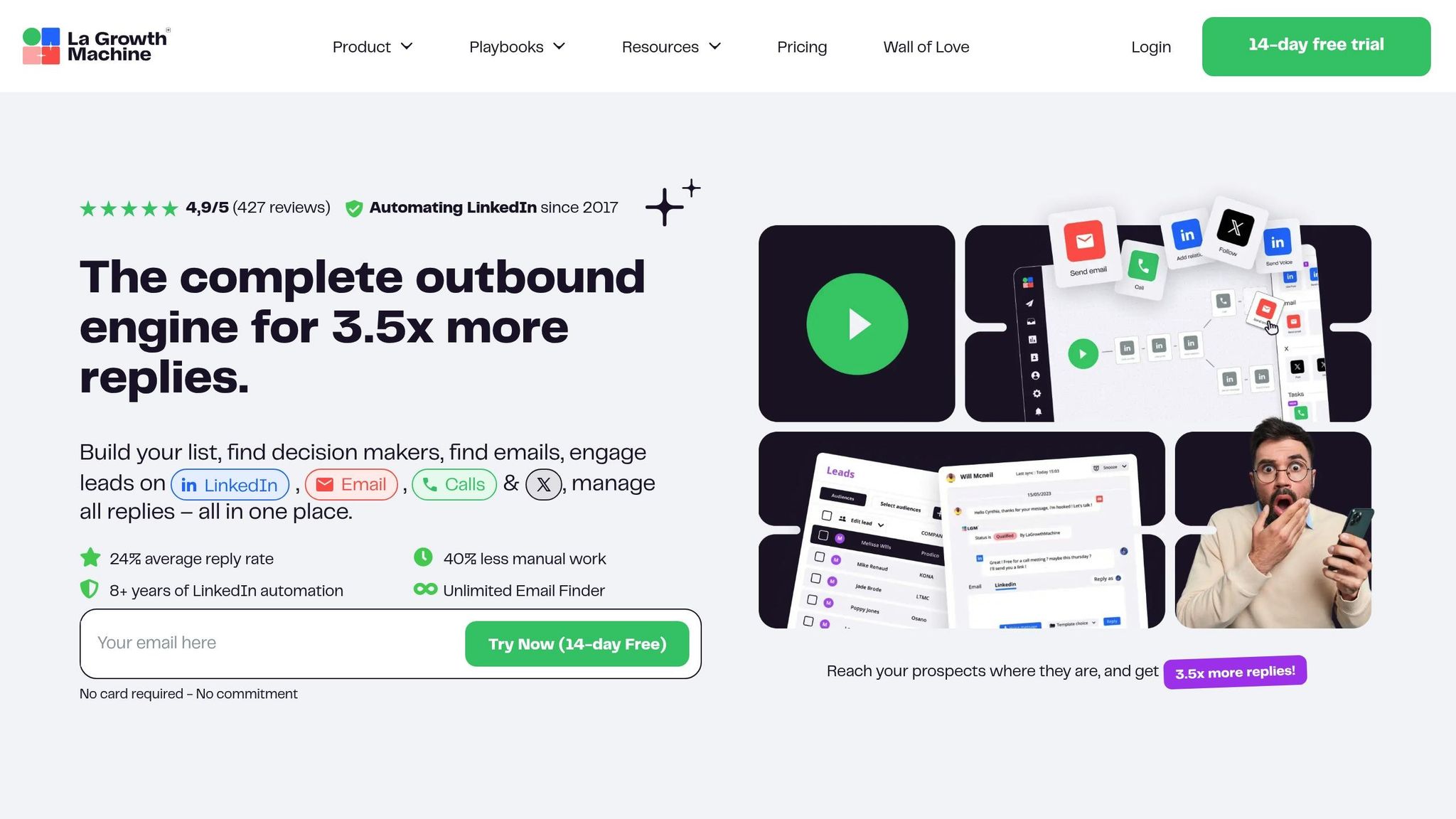
La Growth Machine is a multi-channel outreach tool that combines email analytics with LinkedIn and X (formerly Twitter) engagement. With a 4.9/5 rating from 427 reviews and over 25,000 professionals using it across 70,000+ campaigns, the platform promises to deliver up to 3.5× more replies compared to traditional methods [82, 83].
Real-Time Analytics Capabilities
The platform features a real-time dashboard that tracks every aspect of your outreach campaigns. From emails sent and open rates to response rates and even out-of-office replies, La Growth Machine provides detailed insights into how prospects are engaging. The "Reports" section acts as a central hub for analytics, allowing users to monitor account activity, evaluate campaign performance, and measure team results. This real-time reporting enables users to tweak their strategies on the fly, ensuring campaigns stay effective and aligned with audience preferences. You can also run multiple campaigns at once and compare their performance, making it easier to identify winning strategies.
"La Growth Machine allows us to manage our outbound campaigns, have centralized data on our CRM with the full history of actions and campaigns by contact, and engage in warm calling." – Justin Bollet
Integration with Enterprise Tools and Platforms
La Growth Machine integrates with a wide range of tools to simplify workflows and manage campaign data. Whether you’re using CRMs like HubSpot, Pipedrive, or Salesforce, automation tools like Zapier and Make, or enrichment platforms like Dropcontact and Hunter, this platform has you covered [85, 86]. It also connects with Gmail, Outlook, and personalization tools like Clay, Sendspark, and Hyperise. For cold calling, it supports Ringover, Aircall, and Calendly, and even offers webhook and API access for custom integrations. For example, if a lead downloads content via HubSpot, La Growth Machine can automatically import their data and initiate personalized follow-ups.
Scalability for High Email Volumes
Scaling outreach efforts with La Growth Machine can be tricky due to its pricing model and technical limitations. The platform charges per "identity" (a combination of one LinkedIn, email, and X account), which can make it expensive for teams looking to expand. Additionally, the lack of auto-rotation for LinkedIn accounts can lead to account flags, limiting scalability. Despite these hurdles, features like a unified inbox allow teams to collaborate by centralizing responses from multiple channels. Real-time insights also help fine-tune campaigns as they run. For agencies, the minimum commitment is six identities at $150 each, which can add up quickly for larger teams [85, 89].
Pricing and Value for Enterprise Features
La Growth Machine offers three pricing tiers to cater to different business needs. The Basic Plan starts at $60 per month per identity, the Pro Plan is $100 per month per identity, and the Ultimate Plan costs $150 per month per identity. The Agency plan, designed for larger teams, requires a minimum of six identities at $150 each. While the platform’s multi-channel approach often leads to higher engagement compared to single-channel methods, some users find the higher-tier plans expensive, particularly for smaller teams. There’s also a learning curve when setting up complex sequences [85, 91]. Additionally, access to integrations like Pipedrive and HubSpot depends on the chosen plan, with some tools only available in higher tiers.
Next, we’ll take a closer look at MailerLite, a platform that balances email analytics with affordability for growing businesses.
9. MailerLite
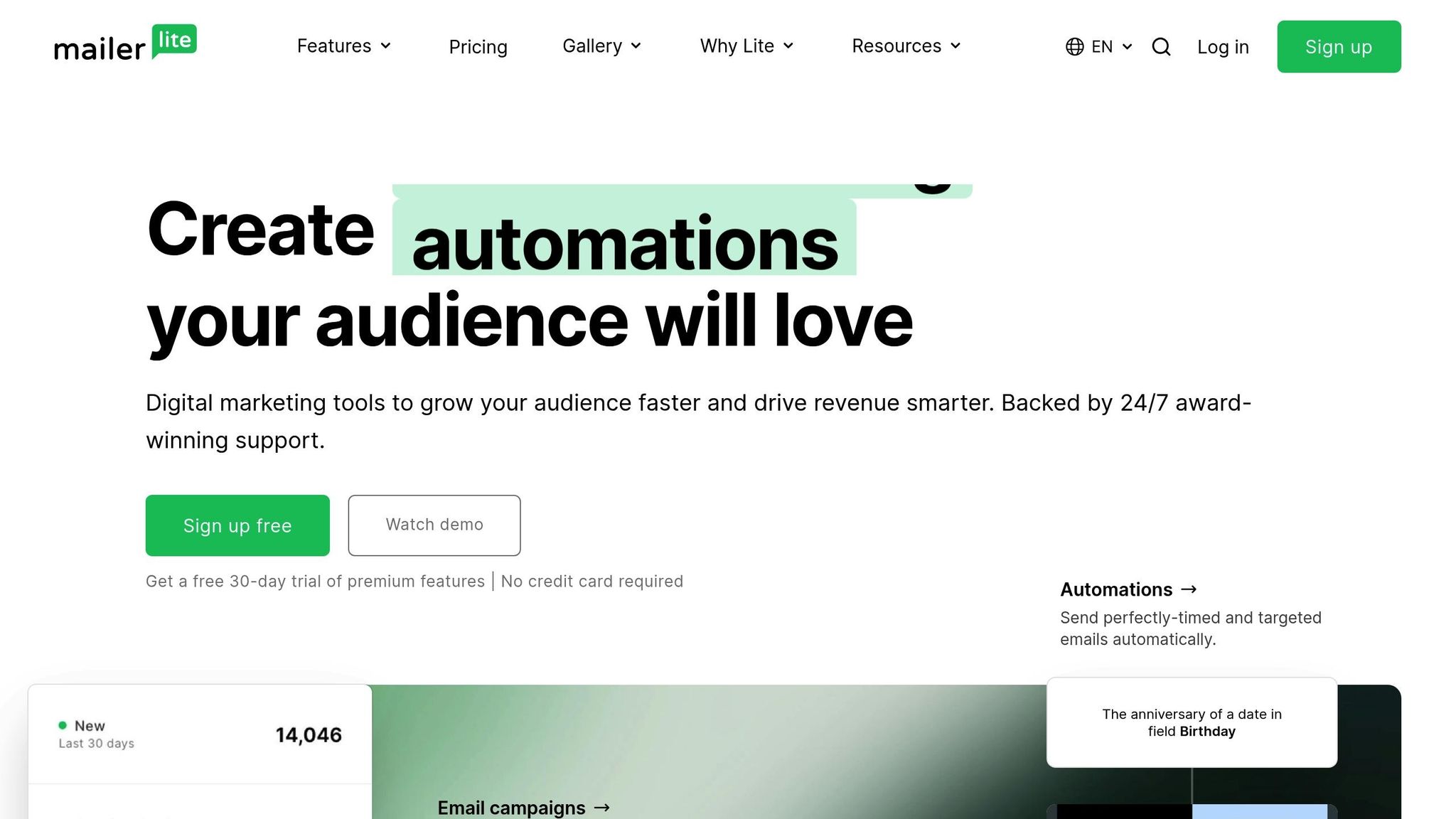
MailerLite is a cost-effective email analytics tool trusted by over 1 million creators and businesses globally. It combines advanced real-time reporting with an easy-to-use interface, offering detailed insights without breaking the bank.
Real-Time Analytics Features
MailerLite provides a deep dive into your email performance through its dashboard, tracking metrics like open rates, click-through rates, forwards, unsubscribes, bounces, and spam complaints - all updated in real-time with visual graphs and charts. Beyond these basics, it also monitors automation workflows, campaign volume, and e-commerce activity. Additional features include heat maps, click maps, analysis of reading environments, identification of top email clients, geographic tracking, and performance stats for landing pages, websites, and forms.
Seamless Integration with Other Tools
MailerLite works well with popular analytics, CRM, and e-commerce platforms. Its integration with Google Analytics, complete with UTM tagging, simplifies tracking newsletter performance. For instance, Shuni, a content marketer at Privyr, shared:
"We wanted to test how easy it was to run campaigns on MailerLite, so we migrated our newsletter audiences first. We realized that our newsletter open rates increased between 15% and 20%."
Collin Thomas, marketing manager at KC Tool, also highlighted MailerLite's impact:
"We like to test everything. Over time, we saw that people like their emails to be straight to the point, so we started cutting back text and focusing on a specific topic. This raised our click rates roughly 1%, which equates to hundreds of people clicking who might not have done so."
KC Tool achieved a 72% open rate and a 7% click rate, while 100daysofnocode, serving a community of 12,000 learners, recorded a 51% open rate and an 11% click rate. These examples show how MailerLite's integrations can drive better results as your subscriber base expands.
Designed for Growth
MailerLite’s pricing adjusts as your business grows. The free plan covers up to 1,000 subscribers and 12,000 emails per month. For larger needs, the Growing Business and Advanced Plans offer tiered pricing, starting at $9 per month and going beyond $260 per month (billed annually). Automatic upgrades handle subscriber growth seamlessly, and custom Enterprise plans cater to businesses with over 100,000 subscribers.
Enterprise Features at a Reasonable Price
MailerLite offers robust features with strong customer feedback - 94% of reviews are positive. For instance, the Growing Business Plan, priced at $125.10 per month for 20,000 subscribers, includes unlimited emails, multiple user accounts, digital product sales, unlimited templates, dynamic emails, auto-resend, and multivariate testing. Gregory John, founder of Buildcamp, shared his experience:
"It's beautiful that I know that if I send out an email to the waitlist segment on MailerLite tomorrow, I could sell out instantly."
Buildcamp achieved an impressive 86% open rate and a 7% click-through rate, showcasing MailerLite’s ability to support high-engagement campaigns.
Next, we’ll take a closer look at Zoho Campaigns and its suite of email analytics tools for businesses.
10. Zoho Campaigns
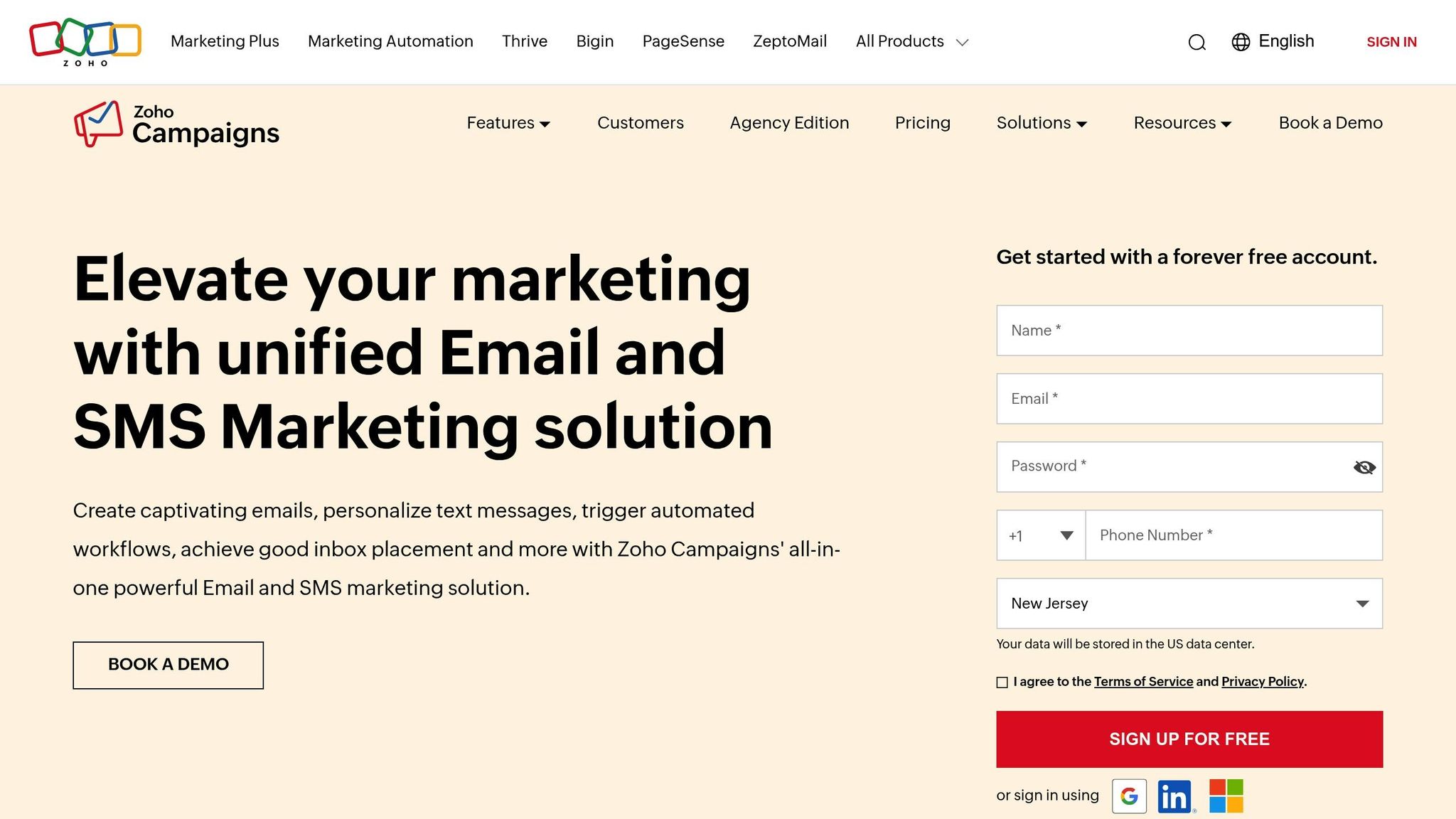
Zoho Campaigns wraps up our list as a robust email analytics tool, particularly suited for businesses already immersed in the Zoho ecosystem. With a global user base of over 3 million and more than 20,000 customers, it combines real-time analytics with seamless integration across Zoho's suite of business tools.
Real-Time Analytics Features
Zoho Campaigns provides in-depth, real-time insights through a variety of reporting options. Beyond tracking standard metrics like opens, clicks, bounces, and unsubscribes, it goes further with geographic reports, social engagement tracking, and user agent statistics - giving you a clear picture of the devices, operating systems, and browsers your audience prefers.
The platform's dual reporting system allows for both list-level and campaign-level analysis, helping you pinpoint audience behavior trends. Automated workflows are supported with detailed, automatically generated reports, so you can monitor complex email sequences without extra effort.
For those needing more advanced insights, Zoho Campaigns offers over 50 pre-built reports and dashboards through its Advanced Analytics feature. These can be shared with your team to identify areas for improvement and to plan follow-up campaigns effectively. Its analytics tools are designed to integrate effortlessly with both Zoho's own products and external platforms.
Integration with Business Tools
Zoho Campaigns integrates seamlessly with the Zoho ecosystem, including Zoho CRM, Analytics, Survey, Books, and more. This creates a unified environment for managing business intelligence.
The Zoho CRM integration is particularly beneficial for sales teams, enabling targeted email strategies using existing customer data and providing a holistic view of the customer journey. Beyond Zoho tools, it connects with external platforms like YouTube, Salesforce, SurveyMonkey, HubSpot, Zapier, Shopify, and Litmus.
David Kreiger, President of Sales Road, highlighted the platform's impact:
"By using Zoho Analytics we are able to greatly increase the effectiveness of our campaigns for our clients".
Similarly, in March 2023, Broadley Speaking leveraged Zoho Campaigns to nurture prospects, with David Conn noting:
"Zoho Campaigns helps us move our prospects closer to sales".
Scalability for Large Campaigns
Zoho Campaigns is designed to grow with your business, whether you're a startup or an enterprise managing extensive contact lists. It offers custom solutions for businesses handling over 500,000 contacts.
For high-volume email senders, dedicated IP add-ons help maintain strong sender reputations and deliverability. At scale, the integration with Zoho Analytics becomes even more valuable, offering detailed insights into large datasets through customizable dashboards and automated reports. This scalability is paired with flexible pricing options tailored to businesses of different sizes.
Pricing and Plan Options
Zoho Campaigns provides flexible pricing structures to match your business needs. The Forever Free plan supports up to 2,000 contacts and 6,000 emails per month.
| Plan | Contacts | Emails | Advanced Features |
|---|---|---|---|
| Forever Free | Up to 2,000 | 6,000/month | Basic features only |
| Standard | Varies by tier | Unlimited | Basic segmentation, up to 10 users |
| Professional | Varies by tier | Unlimited | Advanced segmentation, contact scoring, up to 20 users |
The Standard plan includes unlimited emails with basic segmentation tools, while the Professional plan adds advanced features like segmentation, contact scoring, and enhanced workflows. Optional add-ons such as SMS marketing and dedicated IPs further expand its functionality.
For enterprises with over 500,000 contacts, Zoho offers tailored pricing based on specific volume and feature needs. Additionally, the platform includes a mobile app, allowing teams to manage campaigns and monitor performance from anywhere.
Next, we’ll dive into a comparison of all ten tools to help you choose the best fit for your business.
Feature and Pricing Comparison
Finding the right email analytics tool becomes a lot more straightforward when you can compare them side by side. The ten tools covered here offer a range of features, pricing models, and target audiences, making it crucial to weigh your options carefully.
Enterprise-Level Capabilities and Pricing
Pricing for these platforms spans a broad range. Enterprise plans can cost anywhere from $100 to over $1,000 per month, depending on the features, contact limits, and level of support offered. On the more affordable end, tools like Constant Contact start at $12 per month for the Lite plan, going up to $80 per month for the Premium plan. Similarly, MailerLite offers a Growing Business plan for $10 per month and an Advanced plan for $20 per month. For enterprise-level platforms like Salesloft and Mailgun, pricing is customized based on business needs and usage.
Performance Impact and User Satisfaction
Data shows these tools can significantly enhance performance. For example, response rates can improve by as much as 32%. AI-driven email marketing has also been shown to increase click-through rates by 13% and revenue by 41% compared to traditional methods.
User reviews provide further insight. SalesHandy holds a 4.6/5 rating on G2 from over 710 reviews, while Zoho Campaigns is rated 4.4/5. Meanwhile, Salesloft boasts a 4.5/5 rating on G2, based on feedback from more than 3,891 users .
Feature Differentiation by Use Case
Each tool on this list serves different needs. Some prioritize ease of use with intuitive dashboards, while others focus on advanced automation or developer-friendly APIs. For instance:
- Brevo stands out for its multi-channel automation.
- Mailgun is ideal for developers, offering robust API capabilities.
- Constant Contact caters to beginners with a simple, user-friendly interface.
- SalesHandy focuses on sales team automation.
- Zoho Campaigns integrates seamlessly with the Zoho ecosystem.
Here’s a quick comparison to help you decide:
| Tool | Starting Price | Best For | Key Strength | User Rating |
|---|---|---|---|---|
| Brevo | Free plan available | Small to medium businesses | Multi-channel automation | 4.4/5 (Trustpilot) |
| Constant Contact | $12/month | Beginners | User-friendly interface | 4.4/5 (Trustpilot) |
| Mailgun | Pay-as-you-go | Developers | API flexibility | Technical focus |
| EmailAnalytics | Contact for pricing | Productivity tracking | Gmail integration | Inbox analytics |
| Right Inbox | Subscription-based | Email scheduling | Gmail enhancement | Productivity features |
| SalesHandy | Tiered pricing | Sales teams | Email tracking | Sales automation |
| Salesloft | Enterprise pricing | Large sales teams | CRM integration | Sales engagement |
| La Growth Machine | Custom pricing | Multi-channel outreach | LinkedIn integration | Outreach automation |
| MailerLite | $10/month | Budget-conscious users | Simplicity | Cost-effective |
| Zoho Campaigns | Free for 2,000 contacts | Zoho ecosystem users | Integration depth | 4.4/5 (G2) |
Integration and Scalability Considerations
Enterprise-grade platforms shine when it comes to handling large-scale operations. They provide advanced reporting, seamless integration with ERP and CRM systems, and premium customer support. If your business requires high-volume email capabilities, make sure the tool you choose can handle your growth without compromising performance.
Value Assessment for Different Business Sizes
The pricing structures reflect the diverse needs of businesses. For startups, Zoho Campaigns offers a Forever Free plan that supports up to 2,000 contacts and 6,000 emails per month. Mid-tier tools like Constant Contact strike a balance between features and simplicity, while enterprise-level platforms such as Salesloft and Mailgun provide advanced automation, in-depth analytics, and seamless integrations tailored for larger organizations.
The Email Service Business Directory is a helpful resource for comparing these tools. It provides an extensive list of platforms, software, and agencies to help businesses choose the best solution for managing and optimizing email campaigns.
When deciding on a tool, consider your specific goals, integration needs, dashboard preferences, and scalability plans. With email open rates reaching 26.6% in 2024 - a 6% year-over-year increase - selecting the right analytics platform is more important than ever for boosting engagement and driving results.
How to Choose the Right Tool
Picking the right real-time email analytics tool means understanding your business needs, technical setup, and growth plans. Real-time insights let you make immediate adjustments, but focusing on four main areas will simplify the choice.
Start with integration requirements. Your tool should work seamlessly with your CRM, e-commerce platform, and other marketing tools you already use. Don’t just rely on vague claims of compatibility - verify it works with your specific systems. A well-integrated tool ensures smooth data flow, turning email marketing into a central part of your overall strategy. This way, you can collect, analyze, and act on data instantly.
Think about the depth of analytics you need. Not every business requires the same level of detail. Look for features like audience segmentation, geographic and device trends, and content performance insights. Key capabilities to prioritize include campaign performance details, custom dashboards, automated A/B testing, error tracking, and click maps for link tracking. Personalization is also critical - 78% of marketers rely on it heavily in their email strategies.
Factor in scalability and budget. On average, marketers allocate about 7.8% of their budgets to email marketing, with mid-sized companies spending between $9 and $1,000 per month. Choose a tool that can grow with your business, handling increased email volume and subscriber numbers without skyrocketing costs. As Stephen McClelland, Digital Strategist at ProfileTree, puts it:
"The best email marketing software is the one that scales with your business growth, offering advanced features when you need them without becoming overwhelmingly complex."
Prioritize user-friendly design. Tools with intuitive navigation, clear visual reporting, and customizable dashboards make it easier to act on real-time data. User reviews can be a helpful guide - top-rated tools often score between 4.3/5 and 4.7/5 on major platforms.
Take advantage of free trials and demos to test how well the tool integrates with your systems and whether it fits your workflow. This hands-on experience is invaluable before making a financial commitment. Resources like the Email Service Business Directory can also help you compare tools side by side, ensuring you find the right fit for your needs and budget.
Ultimately, choose a tool that not only meets your current requirements but also positions your business to respond quickly to real-time campaign data and seize new opportunities.
FAQs
What should I look for when choosing a real-time email analytics tool for my business?
When choosing a real-time email analytics tool, it’s important to prioritize features that match your business goals. Start by ensuring the tool tracks key metrics such as open rates, click-through rates, and engagement levels. These insights are essential for measuring how well your email campaigns perform. Opt for a tool that provides real-time data updates, so you can make adjustments on the fly and boost your campaign’s effectiveness.
Another crucial factor is compatibility. The tool should work smoothly with your existing email platforms and marketing software, helping you centralize data and streamline your workflow. A simple, intuitive interface is equally important. This ensures your team can start using the tool effectively without needing extensive training. Lastly, think about your budget and future growth. Choose a solution that fits your current needs but has the flexibility to scale as your business expands.
How do real-time email analytics tools work with CRM and e-commerce platforms?
Real-time email analytics tools work seamlessly with CRM and e-commerce platforms by syncing data and automating tasks. This integration empowers businesses to better understand customer behavior, craft personalized campaigns, and monitor key metrics like open rates and conversions. For instance, CRMs can leverage these tools to automatically segment contacts and customize messaging, leading to higher customer engagement.
In the e-commerce space, these tools offer valuable insights into customer journeys and sales performance by connecting with platforms such as Shopify or WooCommerce. By bridging these systems, businesses can fine-tune email campaigns, improve audience targeting, and make smarter, data-driven marketing decisions.
What are the advantages of using a multi-channel outreach tool like La Growth Machine instead of traditional email-only platforms?
Using a multi-channel outreach tool like La Growth Machine comes with several advantages compared to sticking with email-only platforms. By engaging prospects across multiple platforms - such as email, LinkedIn, and Twitter - you increase your visibility and improve your chances of making meaningful connections. This approach spreads your efforts across different channels, so even if one underperforms, you’re still maintaining consistent engagement.
What’s more, reaching out through multiple channels feels less pushy and more adaptable, giving prospects the freedom to respond using the method they’re most comfortable with. This not only makes the experience more pleasant for them but also helps you build stronger, more genuine relationships. Plus, features like automated follow-ups and a unified inbox simplify the process, making outreach smoother and more effective for your team.


